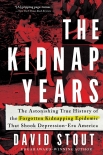The Kidnap Years:, David Stout [readict .txt] 📗

- Author: David Stout
Book online «The Kidnap Years:, David Stout [readict .txt] 📗». Author David Stout
“Had not Charles A. Lindbergh flown the Atlantic…a federal kidnapping statute might not yet have been enacted,” a commentator observed4 after the anti-kidnapping law was passed by lawmakers and signed by President Herbert Hoover in June 1932.
Yes, the ordeal of the Lindberghs roused Congress from its torpor. But well before March 1, 1932, it seemed that people who were not necessarily famous nationally but were well-to-do—brewers, bankers, builders, and merchants—were in danger, as were their children.
While there is no empirical way to gauge a nation’s collective emotion, it may be that the kidnapping and slaying of the golden-curled Lindbergh baby caused more grief, revulsion, and yearning for retribution than any other crime against a private citizen, adult or child, ever.
Charles Lindbergh Jr. was an adorable baby. His heroic father was the son of a former congressman. Charles Lindbergh’s shy, pretty wife, Anne, was the daughter of Dwight Morrow, a wealthy banker, former ambassador to Mexico, and briefly a Republican senator from New Jersey before his unexpected death in 1931 at age fifty-eight.
Before the Lindbergh horror, enactment of a federal kidnapping law was hardly a sure thing. The U.S. attorney general, William D. Mitchell, argued against it on grounds that it would increase federal spending and make the states too dependent on Washington.
But with the discovery of the Lindbergh baby’s body on May 12, 1932, things changed literally overnight. On May 13, President Hoover, ignoring the reality that the U.S. government had no jurisdiction over kidnappings, ordered federal law enforcement agencies to aid state and local investigators “until the criminals are implacably brought to justice.”5
Representative Charles Eaton, a New Jersey Republican, was similarly outraged, declaring after the baby was found dead that the Lindbergh family was “the symbol of all that is holy and best in our nation and civilization.”6
The chaplain of the House of Representatives, the Reverend J. S. Montgomery, offered a prayer for the child, then urged lawmakers to “arouse the public conscience, that a slight atonement may be made, by smiting murderers and outlaws into the dust.”
At the dawn of the 1930s, taking a kidnapping victim across a state line was a smart tactic. In that predigital era, there wasn’t much coordination and cooperation among the police and courts of the states. Most states did not have statewide police forces. Potential witnesses in a state to which a victim was taken were beyond the subpoena reach of courts in a state where the kidnapping had taken place. Laws against kidnapping varied from state to state. Extradition was cumbersome. Fewer than half of American households had telephones.
And sadly, some local cops augmented their modest incomes by taking money in return for not chasing criminals too aggressively.
What became known as the Lindbergh Law was sponsored by Missouri lawmakers Senator Roscoe Conkling Patterson, a Republican, and Representative John Joseph Cochran, a Democrat from St. Louis. A number of kidnappings had taken place around Kansas City and St. Louis. Both cities were influenced by, some would say run by, organized crime. A lot of kidnappings were carried out by professional criminals who had branched out from gambling, bootlegging, and other illicit enterprises.
But some kidnappings were the work of amateurs, driven to desperation because they had no jobs and no prospects. And some people plumbed the depths of human cruelty by posing as kidnappers, sending ransom demands to relatives of the victims while knowing nothing of the victims’ whereabouts.
What made Kansas City, Missouri, and St. Louis such hotbeds of kidnapping? The first city, of course, is next door to the identically named city in the state of Kansas. St. Louis, which sits on the Mississippi River, was even more ideally situated. Kidnappers could take a bridge across the river and be in Illinois in minutes. And for kidnappers with boats, the mighty river offered access to the entire Midwest. Thus, St. Louis, which was known in frontier days as the “Gateway to the West,” could have been dubbed “the Kidnap Turnstile” in the 1930s.
“Kidnapping is the feature crime of the present time,” Walter B. Weisenberger, president of the St. Louis Chamber of Commerce, told the Senate Judiciary Committee as he urged federal anti-kidnapping legislation days after the Lindbergh infant was stolen. “It is a crime that men with some of the best brains in this country have gone into, because it offers big returns and reasonable safeguards.”7
Some of the best brains in the country? Perhaps Weisenberger exaggerated the intellects of most kidnappers. But there was no denying that they were an industrious lot. The St. Louis police chief, Joseph Gerk, claimed to have collected statistics from cities nationwide in 1931. He told Congress he had counted 279 kidnappings that year, in the course of which thirteen victims were killed and sixty-nine kidnappers captured and convicted.8
But those numbers were unreliable, as Gerk acknowledged. He had sent questionnaires to the police in 948 cities but received replies from just 501. States and cities did not routinely share information with one another, as indicated by the limited cooperation for Gerk’s survey.
The day after the Lindbergh kidnapping, a New York Times article offered a partial list of the most recent kidnappings in various states: Illinois, 49; Michigan, 26; California, 25; Indiana, 20. And so on. The following day, attributing its figures somewhat vaguely to “authorities,” the paper reported that more than two thousand persons had been abducted in the country in the previous two years.9
No doubt, many kidnappings went unreported, as some of the victims were criminals themselves, grabbed by rival gangsters, then sold back to their





Comments (0)